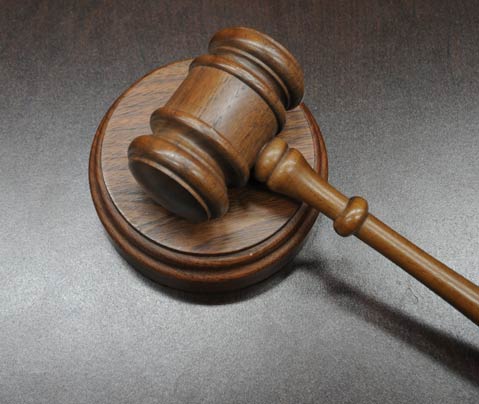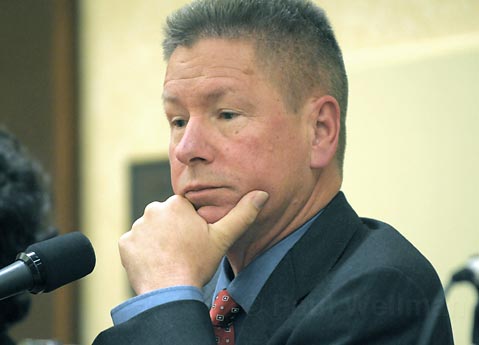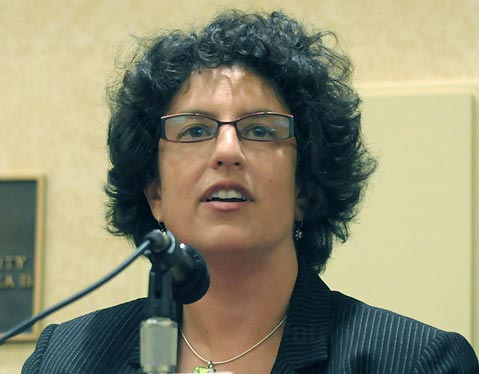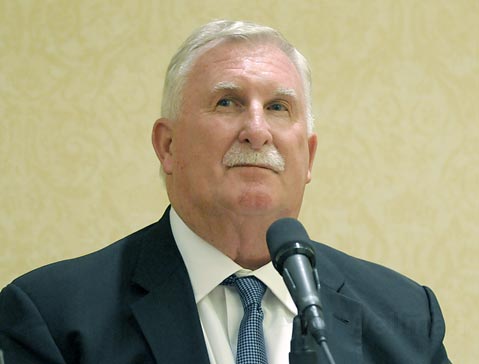Who Will Bang the Gavel?
Santa Barbara Mayoral Contest Underscores Power Grab at City Hall

This year’s mayoral contest is the focal point of a concerted political power play the likes of which Santa Barbara has not seen since the Spaniards took over from Chumash chief Yanonalit or when the Yankees wrested control from the Mexicans. Shrewdly conceived, boldly executed, and obscenely bankrolled, this plan would bring to an end the 35-year reign of moderate slow-growthers and environmental-minded Democrats over Santa Barbara’s nominally nonpartisan City Hall. Installed in their place would be a fiscally restrained mayor and council majority, decidedly more Republican, notably more conservative, and wedded to notions of civic government emphatically more limited than any in recent memory.
Whether this plan succeeds depends ultimately on voter turnout; typically, high turnouts favor more liberal candidates, low turnouts the conservatives. Thus far, voter response to the city’s first-ever mail-in-only ballot has been conspicuously lackluster: With the election deadline on Tuesday, November 3, around 9,500 of the city’s 46,000 registered voters have cast ballots. Also to be determined is how much the outcome will be shaped by the staggering infusion of campaign cash-$500,000 and counting-from Randall Van Wolfswinkel, the Texas real estate developer with Santa Barbara roots who is supporting conservative candidates and Measure B, the reduced building heights initiative.
Under Santa Barbara’s system of government, the city administrator-not the mayor-is the most powerful person at City Hall. Technically, the mayor’s is just one of seven equal votes. But the position packs more punch than mere numbers indicate. The mayor runs council meetings and, as wielder of the ceremonial gavel, governs who can speak, for how long, and with what degree of civility. More than anything, however, the mayor serves as the voice of the city in good times and bad. As occupant of the city’s loudest bully pulpit, the mayor has the opportunity to define the issues of community concern in ways ordinary councilmembers cannot.
This year, five individuals are vying for the top post. Two-Bob Hansen and Isaac Garrett -have opted not to raise the funds necessary for electoral success. The other three-liberal Democrat Councilmember Helene Schneider, conservative Republican Councilmember Dale Francisco, and middle-of-the-road Chamber of Commerce President Steve Cushman-are deadly serious. Of these, two are running as headliners for de facto, quasi-cohesive slates: Francisco’s campaign is tied to Van Wolfswinkel-backed city council candidates Michael Self, Frank Hotchkiss, and Cathie McCammon, while Schneider’s run is allied with council candidates Grant House, Harwood “Bendy” White, and Dianne Channing. By contrast, chamber boss Steve Cushman, though a lifelong Democrat, has no political posse. Instead, he’s hoping to persuade voters that his lack of affiliation endows him with the independence and pragmatism needed to tackle the tough challenges now confronting City Hall.

Dale Francisco
With fewer than two years of office under his belt, Dale Francisco-the City Council’s sole Republican and a former computer systems analyst-often has found himself on the losing end of 6-1 votes. This has emboldened the quick-witted and sharp-tongued Francisco to wage a classic “throw-the-bums-out” campaign.
The last candidate to enter the race, Francisco has blistered Schneider and her council colleagues for mismanaging the city’s fiscal crisis by squandering the city’s “rainy-day funds.” These were paid out to the public employee unions that have donated so generously to the campaigns of Schneider and her cohorts, Francisco charges, pointing specifically to the 2.5-percent pay hike the council approved for city employees represented by the Service Employees International Union (SEIU) this February.
Francisco is also campaigning against aggressive panhandlers, contending that “the astonishing level of social services” in the area draws individuals intent on living “dead-end lives” at the city’s expense. “Too many people living on the street have a real sense of entitlement,” he said. Likewise, Francisco has castigated City Hall for not doing enough to curb gang violence, charging that his fellow councilmembers have allowed themselves to become distracted by what he terms “boutique issues,” including many environmental concerns such as the garbage-to-energy-conversion plant now under consideration for the Tajiguas Landfill. “The primary focus should be on public safety and infrastructure,” he said. “When these have been addressed, everything else falls into place.”
For a conservative Republican, such issues hardly are innovative. What distinguishes Francisco, however, is his support for Measure B, the ballot initiative that would reduce maximum allowable building heights by one-third. This support has enabled Francisco to tap into a fertile voting bloc of old-school slow-growthers. Many are registered Democrats, but some have grown increasingly alienated by the high-density-and-alt-transit schemes advocated by the “New Urbanists” within the party and City Hall. To the extent Francisco can win their hearts and minds, he can overcome the political stigma of being a Republican in a town where registered Democrats are the overwhelming majority.
What gives Francisco serious chomping power is the astonishing outlay of campaign cash by Van Wolfswinkel. Francisco has taken pains not to accept one dime from either Van Wolfswinkel or his political action committee, Preserve Our Santa Barbara, but he hasn’t had to. To date, Van Wolfswinkel has spent more than $40,000 on ads extolling Francisco’s leadership virtues and more than $100,000 on negative ads damning Schneider and Cushman, suggesting that the latter has communist ties due to a $50,000 donation from Russian billionaire banker and part-time Montecito resident Sergey Grishin.
Francisco has said repeatedly that he had nothing to do with Van Wolfswinkel’s ad campaign. “I think that stuff is pretty stupid,” said Francisco, who has raised $83,000 on his own. “From what I’ve seen, I’m not sure they have a good appreciation of what works in Santa Barbara.”
Francisco’s critics contend his conservative politics are at odds with mainstream Santa Barbara voters. Schneider is quick to highlight Francisco’s support-campaign finance records show he donated $200-for the anti-gay marriage Proposition 8, which passed last year. People who have discussed the matter with Francisco-who is neither religiously affiliated nor married-say he passionately regards traditional marriage as the cornerstone of modern civilization. But Francisco has declined to discuss the issue with reporters. “My beliefs about gay marriage, abortion, and gun control might become relevant if I ever run for president,” he said, “but I have never used my position to advance some kind of cause outside of what the City Council is all about. And I’m not going to.”
Some Democratic Party activists are trying to make an issue out of Francisco’s position on illegal immigration. Francisco has stated that the influx of illegal immigrants needs to be controlled, that the children of undocumented workers have placed a drain on schools and hospitals, and that City Hall should deploy the controversial E-Verify computer system to ensure that it does not hire anyone without proof of legal documentation and require its private contractors to do the same. But E-Verify, said Democratic Party spokesperson Daraka Larimore-Hall, will force immigrants further underground, negatively impact criminal investigations that rely on open communication between immigrants and cops, and exacerbate public health problems by scaring away sick people from treatment. Larimore-Hall also claimed that Francisco has yet to acknowledge the economic contributions such workers make to state and federal tax coffers and is only focused on the costs. Francisco countered that the easy availability of illegal labor has only depressed wages for the most vulnerable workers.
If elected, Francisco plans to streamline the Tuesday meetings by shortening staff presentations, mandating reports be made available at least a week before, and objecting to resolutions on such controversies as the Iraq War or offshore oil. Such plans also reflect a critique of Francisco raised by Schneider-that he loses his cool too easily with perennial City Hall gadflies. In one instance, Francisco got up and left the council chambers after a prominent school board critic complained she’d been “raped” by the school district. “The people of Santa Barbara have been too complacent and too lenient,” said Francisco, who promised that his responsibility to city government will trump any other political considerations. “I’m talented at framing political issues. I’m not afraid to speak my mind,” he said. “But I will really listen.”

Helene Schneider
Leading the charge on behalf of the so-called bums is six-year Councilmember Helene Schneider. At age 36, Schneider is considerably younger than previous mayors. Emerging out of the activist, progressive, and feminist base of the Democratic Party, Schneider campaigned for Jack O’Connell’s state senate bids, landed a paying gig at Planned Parenthood, and made her way up the ranks of the Women’s Political Committee. There, Schneider impressed colleagues with her quick intelligence, hard work, and unflappable ability to finesse challenging personalities. During the past six years in office, Schneider pushed a decidedly progressive agenda-tenant protections, affordable housing, and the much vilified Light Blue Line-but in the rhetoric of the wonk, not the firebrand. From city staff and lobbyists-even those she’s sided against-Schneider typically garners high marks for smarts and sincerity.
But she’s also a politician. While initially critical of Measure B, Schneider has since adopted a “no-position” position, arguing she’ll need to work in the future with both supporters and opponents. For this, she’s been criticized for lack of leadership not just by her mayoral rivals, but by affordable housing advocates as well. On occasion, Schneider has clashed with more established party elders about politicians she’s endorsed-such as fellow Councilmember Das Williams when he ran against Janet Wolf for county supervisor-and even on her own mayoral candidacy. Ironically, this upstart activist now finds herself tagged the “status quo” candidate. With party leaders unified behind her, a robust campaign war chest of $138,000, and the Democrats’ clear advantage in registered voters, this should be Schneider’s campaign to lose. But tapping the political optimism that energized so many Santa Barbarans to volunteer for Barack Obama last year is proving easier said than done, especially when Schneider must appeal to moderate voters without cooling the ardor of her base.
As a councilmember, Schneider has taken on such politically thorny and logistically complex issues as the county’s 10-year plan to end homelessness and the “12-point” plan to deal with panhandlers. It’s not just another pie-in-the-sky plan, Schneider insisted; it gets results. “We’ve gotten 300 people off the streets already,” she said. “That’s tangible.” While some rivals and business owners complain about aggressive panhandling, Schneider complains more about the dearth of detox beds-only 12 on the South Coast-available to the homeless.
On budget matters, Schneider does not apologize for her vote to approve the pay raise negotiated by SEIU. “Because of that deal, general workers are now taking home 2.5 percent less than they did a year ago; management employees are taking home 5 percent less than they did a year ago,” she said. “We cut millions of dollars without any involuntary layoffs and without sending anyone to the unemployment line.” The coming year promises to be grueling, she said, and all unions-even the police officers-need to come to the bargaining table. “If we only cut programs in Parks & Recreation,” she said, “I can tell you the police department’s job just got a whole lot tougher.” As for the $9 million in budget reserves she allegedly helped squander, Schneider said that number is greatly exaggerated. Some of the reserves, she said, were spent to secure bicycle patrol officers for gang-afflicted neighborhoods, after-school programs for junior high school kids, graffiti abatement, and the “over-hiring” of new police officers to ensure that attrition and turnover did not diminish the number of sworn officers.
On Measure B, Schneider acknowledged that she underestimated the urgency of community discontent regarding the big buildings sprouting up along Chapala Street. She thought such concerns could be handled by Plan Santa Barbara, but now believes that planning process has taken too long. On affordable housing, Schneider pushed for tougher inclusionary housing requirements, which rival Francisco branded at the time as “extortion” and which slow-growthers believe has led to the mansionization of mixed-use projects. Schneider countered that inclusionary requirements were just one tool to achieve workforce housing and recalled the two years she spent working on the Neighborhood Preservation Ordinance, which has given residents and city planners alike a better handle on the so-called McMansions sprouting up in residential neighborhoods.
On the cultural wars being waged over bulb-outs and other traffic-calming devices, Schneider acknowledged the installation of those on the upper Eastside was, at best, clumsy. “But we get letters all the time telling us we need to deal with speeders,” she said.
Schneider still bristles at the mention of the Light Blue Line, the controversial public art project she promoted to highlight the local effect of global warming. Ultimately, the uproar over the project-from real estate professionals worried that it would depress property values to council critics upset with the politics of symbolic sideshows-forced Schneider to abandon the effort. She insists the idea had been vetted in city committees thoroughly and was not the sneaky backroom maneuver critics alleged. “In hindsight, we should have proposed drawing the line in chalk,” she said, “not paint.”
Santa Barbara is not just any other city, she said, and efforts to impose a back-to-basics agenda will collide with the high degree of input civic participants have come to expect. For instance, plans for the new airline terminal were subjected to an intense degree of community involvement, she said. As a result, Santa Barbara will have the first new Spanish colonial terminal built in many years, it will be environmentally sound, and it will feature a public art display. “That’s Santa Barbara,” she said.
One of the raps on Schneider is that she hasn’t reached out sufficiently beyond her comfort zone and into the business community. As mayor, she said, her role will be more encompassing. “To those people, I’d say give me a chance.”

Steve Cushman
For voters who might think Francisco is too conservative or Schneider’s too liberal, then Steve Cushman is hoping to emerge as the just-right Goldilocks candidate. A large man with deep-set eyes, Cushman exudes a cheerful masculine optimism colored by an accent of absurdist humor. A lifelong Democrat, Cushman describes himself as a social liberal and fiscal conservative. He jumped into the mayoral contest when it appeared it would be a showdown between Helene Schneider and fellow Democratic Councilmember Iya Falcone. Cushman saw little difference between the two candidates, both, in his mind, having run up city expenses much faster than revenues, both backed by public employee unions, and neither able to get the city out of its fiscal jam. By contrast, Cushman promised to bring 19 years of Chamber of Commerce experience, during which time he’s sat on more than 90 nonprofit boards of directors and raised umpteen millions of dollars.
Since then, however, Falcone dropped out and Francisco jumped in, drastically altering the political geometry of the race. Conventional wisdom holds Cushman and Francisco will split the conservative-to-moderate voting blocs, all but assuring victory for Schneider. Little wonder, then, that Francisco has focused much of his firepower on Cushman.
If elected, Cushman would keep his Chamber job, which he says the mayor of Culver City did without incident. Cushman takes umbrage at the suggestion he couldn’t do both and, at a forum on the Mesa, he expressed genuine anger at Francisco-whom he refers to as “Dale Van Wolfswinkel”-for saying so. Both Francisco and Schneider contend that being mayor is more than a full-time job-outgoing Mayor Marty Blum stated she works about 57 hours a week-but Cushman said he studied how much time the job takes as part of a compensation committee five years ago. “We concluded it’s a part-time job,” he said. Privately, he said Blum assured him the job could take as little as three hours a day, except for Tuesday when the council meets. Blum later said that would cover only the paperwork involved, and doesn’t include the many public events a mayor is asked to attend. It’s not a new controversy for Cushman. He cites the eight years he successfully ran both the Chamber of Commerce and the Downtown Organization (DO) at the same time. But Cushman also acknowledged that he ultimately was forced to give up his post as DO executive due, in part, to membership unrest.
To the extent Chamber presidents are expected to embody the moss-backed conservative stereotype, Cushman disappoints. A poet, sculptor, and former bookstore and health club owner, Cushman has embraced the Santa Barbara arts community in ways his Chamber predecessors never did. Given the arts community’s clout, that was smart politics. But to Cushman, it was good business. Santa Barbara could be sold for its arts scene as well as a surf-and-turf destination. On occasion, there was friction. Cushman recently was blistered as a bully for his response to a writer complaining about the Chamber’s unsuccessful management of a past Book and Author Festival. In an email, Cushman told the writer that any suggestions he had would be assiduously ignored, and concluded, “Take the money and buy some happy pills.” Cushman said he popped off because the writer had dissed Chamber employees, defending his reply “as one of the great lines of all time” and adding that the Chamber had taken over management of the festival only after it fell on hard times. “It’s another case where no good deed goes unpunished,” Cushman said.
On the campaign trail, Cushman exudes a breezy amusement. At times, it’s not clear if he’s joking or serious. But he’s certainly serious about the looming budget crisis. “I don’t think we appreciate the enormity of the problem,” he said. “Now it’s down to layoffs, pay cuts, and service reductions. But we can get through this if we all work together.” City Hall could make some money if it privatized the parking garages; private operators, he said, wouldn’t let people who park late escape without paying, as they do now. He dismissed Measure B as “ballot box planning,” predicting it would have negative unintended consequences.
On the homelessness issue, he said aggressive panhandlers aren’t really a big problem, so much as poor people are in plain sight. “We hear about it all the time from visitors,” he said. “They expect Santa Barbara to be perfect. It surprises them to see poor people.” Given that so many of the social services the homeless rely upon are located downtown, he said that’s inevitable. Cushman has suggested that perhaps the downtown shelter could be sold and the proceeds used to secure bigger accommodations elsewhere.
On gangs, he said City Hall already has a good plan-direct services to the families who need it most with better coordination between public and private social services as well as law enforcement agencies-it just needs to be put into practice. Long-term, he said, the real problem is that schools aren’t teaching kids to read well enough. “If you’re a 6th grader reading at a 2nd-grade level, what do you think’s going to happen?” he asked. As mayor, Cushman said he could help focus energy and creativity of the entire community on pressing social issues. “We could decide to keep the libraries open seven days a week,” he said. “We could make sure that when kids entered school, they had the reading skills they needed to succeed. This is a wealthy community. We can do these things.”
Cushman predicted he’ll win by 120 votes. He’s targeting residents who voted in 2008’s presidential election, but who did not vote in the past two City Council races. These are the least ideological voters, he reckoned, and ones most open to his appeal. Cushman said he was caught totally by surprise by the tenor and intensity of this year’s election. “I don’t think it could be any nastier,” he commented. He described the meeting in which Russian banker Sergey Grishin wrote him a check for $50,000-an unprecedented donation even in the context of Van Wolfswinkel’s spending-as “totally surreal.” If people are interested in campaign finance reform, Cushman-who has raised $128,000 in total funds-said City Hall should consider shortening the campaign season to just one month. “I don’t mind begging for a good cause,” he said. “But does spending other people’s money to buy campaign advertising rise to the level of a ‘good cause’? Somehow, I don’t think so.”



